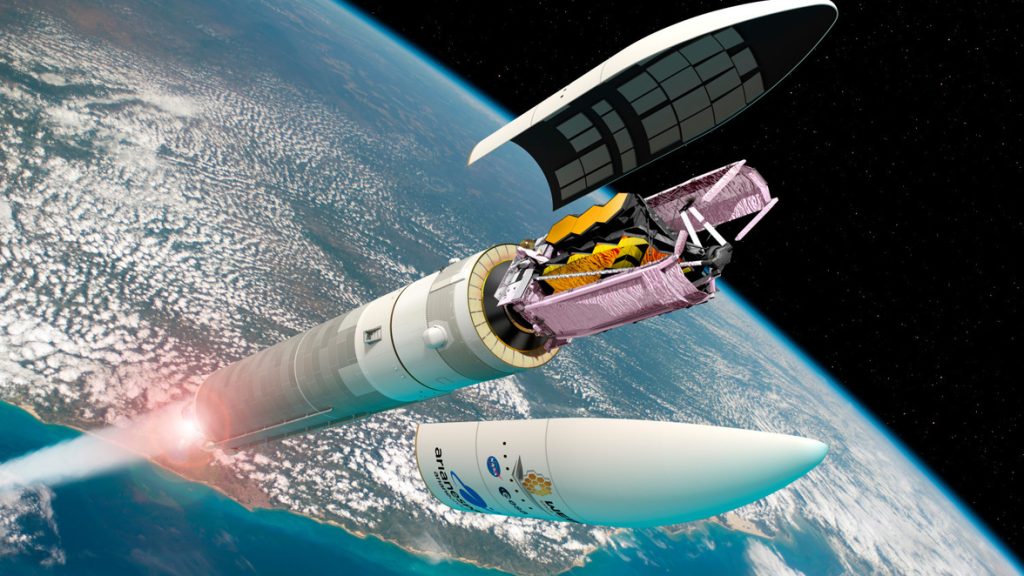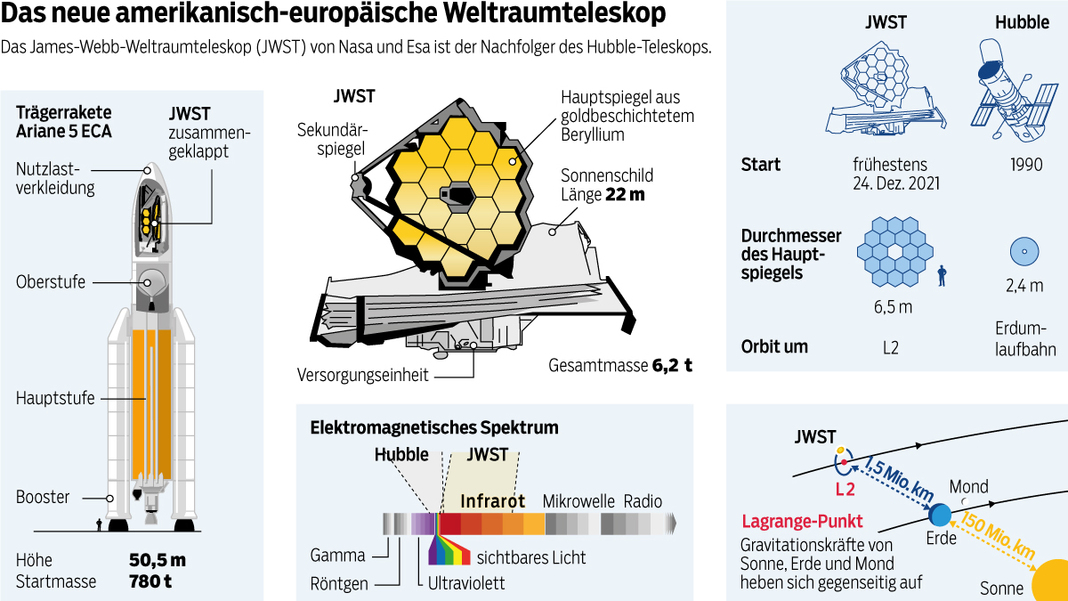Looking at billions of years in the universe – that’s what the new James Webb Space Telescope promises. after Decades of development and multiple delays The date of the rocket carrying the precious cargo is supposed to be Christmas Day (December 25). A spaceport in Kourou, French Guiana beginning.
The new telescope far surpasses its predecessor, Hubble, in size and complexity. for him Mirror has a diameter of 6.5 meters And you need to fold it to fit an Ariane 5 rocket that will launch the telescope into orbit.
The James Webb Telescope will explore the early days of the universe, just a few hundred million years after the Big Bang. The US space agency “NASA” explains that it “will directly observe an unprecedented portion of space and time.”
More research into space means to look no further To see again in time. While it takes sunlight eight minutes to reach our eyes on Earth, the new telescope will capture the light of the first galaxies, More than 13.4 billion years ago Originated.
The Hubble satellite, which has been in use since 1990, mainly monitors visible light. Web, on the other hand, focuses on that Infrared. The telescope will provide more accurate images, with a sensitivity 100 times higher, says Swiss astrophysicist Pascal Auch. He is sure that “more and more galaxies will be revealed, but they will be less bright.”
Webb aims to help explain a key stage in the evolution of the universe, when “the lights appeared when the first stars began to form,” Ochs explains. In the end it is also around Find out if the Earth is unique Or whether there are similar planets on which life could arise.
The new telescope, named after a former US space agency administrator, was jointly developed by NASA, the European Space Agency (ESA) and the Canadian Space Agency (CSA). The Max Planck Institute for Astronomy, the University of Cologne and several German companies also participated in the conference.
The project, which began in 1989, was originally supposed to start in the early 2000s. New problems delayed the project Costs tripled to nearly $10 billion (8.8 billion euros).
“There’s a lot of excitement, we’ve been waiting for this moment for a long time,” says Pierre Verroet, a scientist at the European Space Agency who has devoted most of his career to the project. Researchers are already vying for access to the new telescope that orbits our sun.
“The demand for observation time is very high. In the first year of operation alone, the European Space Agency received more than a thousand requests,” says Viruet. “Even after 20 years, the questions Webb is designed to answer are just as urgent.”
But it will take some time before the telescope delivers the first images: in about a month It should reach its orbit 1.5 million kilometers from Earth. Then the mirror and sunscreen the size of a tennis court should open. Only when this challenge is mastered and the mirror is finely tuned can a look into the universe’s past begin in about half a year.
Telescope Start Live: ESA Live Broadcast
The James Webb Telescope was supposed to start on Christmas Eve
The launch of the new James Webb space telescope, which had already been postponed several times, was delayed because of this. Bad weather forecast again. The Ariane 5 launch vehicle is expected to take off from the Kourou spaceport in French Guiana on Saturday, December 25, NASA announced. It would be one day after it was last planned. This isn’t the first time the kick-off for the joint project between space agencies in Europe, the United States and Canada has been postponed. Originally it would have been in October 2018 It must be up to date.
James Webb Telescope: 1.5 million km voyage length
It is said that the telescope is in orbit More than a million and a half kilometers from Earth Placed about four times away from Mouth. Unlike the previous Hubble telescope, the Webb telescope will be It does not revolve around the earth, but around the sun.
The telescope will take about a month to reach its destination, known as Lagrange Point II, or L2. If astronauts could fix Hubble, humans would never have gotten this far in space.
This is the mission of the Webb Telescope
The telescope is supposed to explore the early days of the universe, only a few hundred million years after the Big Bang. Astronomers hope to draw conclusions about the formation of the first stars and galaxies. In addition, the telescope must have exoplanets, so Planets outside the solar system, explore. In addition, you must investigate whether these alien worlds can harbor life.
The strength of the Webb telescope lies in its use of infrared radiation. While Hubble works mostly with visible and ultraviolet light, infrared rays from the Webb telescope can more easily penetrate the universe. In addition, astronomers can look into the past more using infrared radiation.
The Webb Telescope is also supposed to show Mars and Mars surrounded by an ice shell Jupiter Mond Europa Examine closely.






More Stories
Nvidia GeForce RTX 4090: AIDA64 gets Ada spearhead support
Rogue Trader – Details about the first cRPG in the series – CD-Action
t3n – Digital Pioneers | digital business magazine